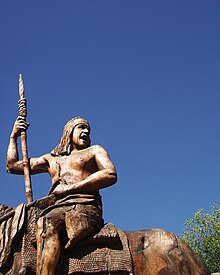Pelantaro
Pelantaro (also Pelantarú , from Mapudungun pelontraru , about "seeming bird of prey") was a Toqui (war chief) of the Mapuche of the 16th and 17th centuries in what is now the Little South of Chile .
biography
In the second Mapuche rebellion, which began in 1598, Pelantaro was initially Vice-Toqui under Paillamachu . Pelantaro and his followers Anganamon and Guaiquimilla are credited with killing the second Spanish governor of Chile, Martín García Óñez de Loyola , during the Battle of Curalaba on December 21, 1598. This battle is considered to be the end of the Conquista in Chilean history ; According to tradition, the attacking Mapuche did not even know at first that they had just killed the governor.
The disaster of Curalaba was followed by the destruction of the seven cities south of the Río Bío Bío from 1599 to 1605: Santa Cruz de la Coya , Valdivia , Angol , La Imperial , Villarrica , Osorno and Arauco .
As war trophies and chicha containers, Pelantaro always carried the severed heads Martín García Óñez de Loyolas and Pedro de Valdivias with him. As a demonstration of his will for peace, he gave it to the Spanish colonizers in 1608.
In 1616 he was captured for a year and a half; after the death of the governor Alonso de Ribera , he was released by his successor Fernando Talaverano Gallegos .
Web links, literature
- Crescente Errázuriz: Seis años de la historia de Chile (23 de diciembre de 1598 - 9 de abril de 1605), Tomo I y II . Imprenta Nacional, 1882–1908 (Spanish)
- Alonso González de Najera: Desengaño y reparo de la guerra de Chile . Editorial Andrés Bello, Santiago de Chile, 1971 (Spanish)
- Diego Ocaña: Viaje a Chile: relación del viaje a Chile, año de 1600, contenida en la crónica de viaje intitulada “A través de la América del Sur” . Colección Escritores Coloniales, Editorial Universitaria, 1era. Edición, Santiago de Chile, 1995 (Spanish)
- Alonso de Ovalle: Histórica relación del Reino de Chile y de las misiones y mini terios que en él ejercita la Compañía de Jesús ... . Reproducción digital de la edición de Roma, Francisco Caballo, 1646, Alicante: Biblioteca Virtual Miguel de Cervantes, 2007 (Spanish)
- Roger Arteaga Cea: Pelantaro: el gran toqui de Purén (Spanish; PDF; 317 kB)
- Historia de Chile en Cómic: Episodio XIV: La venganza de Pelantaro . Las Últimas Noticias (Spanish)
| personal data | |
|---|---|
| SURNAME | Pelantaro |
| ALTERNATIVE NAMES | Pelantarú, Pelontraru |
| BRIEF DESCRIPTION | Mapuche warriors |
| DATE OF BIRTH | 16th Century |
| DATE OF DEATH | 17th century |
